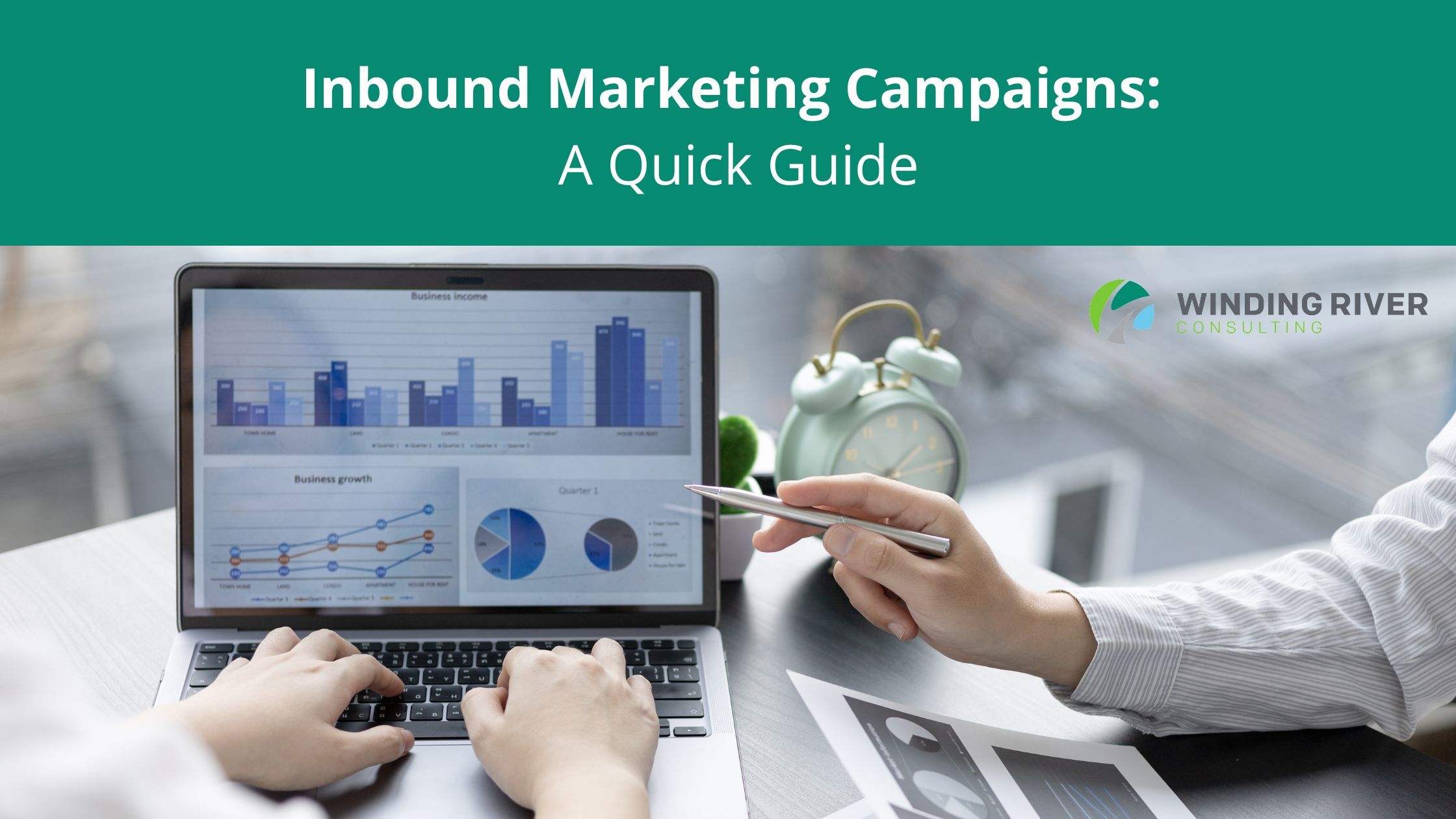4 min read
Inbound Marketing Campaigns: A Quick Guide
As a firm leader, you know how important marketing is to the continued success of your practice. You’re cognizant of the fact that the digital...
14 min read
by:
 David Toth
on
Feb 07, 2024
David Toth
on
Feb 07, 2024

David empowers firms to grow strategically by aligning innovation, insight, and execution. He leads WRC’s signature programs and advises firm leaders on M&A, digital growth, and leadership development.
Table of Contents
Question: How much does inbound marketing cost in 2024?
Answer: Effective inbound marketing should cost 10-13% of a company’s annual revenue.
Take this Article To-Go
Complete the form below to download a pdf of this article.
In the ever-evolving digital marketing landscape, one question that consistently surfaces for businesses of all sizes is: “How much does inbound marketing cost?” The answer, while not straightforward, can be estimated to fall within the range of 10-13% of a company’s annual revenue according to research by Gartner.
This investment in inbound marketing is not just a cost; it’s a strategic allocation of resources towards long-term, sustainable growth. However, it’s important to understand that several variables can influence this cost. Factors such as the industry you operate in, the current level of brand recognition your business holds, the competitive environment of your market, your specific marketing goals, and the timeframe you have set to achieve these objectives, all play a crucial role in determining the overall investment required for effective inbound marketing.
As we delve deeper into the specifics of inbound marketing costs in 2024, it’s essential to recognize that this form of marketing is not a one-size-fits-all solution. The digital world is dynamic, and with each passing year, new trends and technologies emerge, influencing the way businesses approach their marketing strategies. Inbound marketing, known for its customer-centric approach, requires a nuanced understanding of your target audience and the creation of tailored content that resonates with them. This approach, while more personalized and often more effective in the long run, demands a careful consideration of various cost elements. From content creation and SEO optimization to social media strategies and the use of marketing automation tools, each component of inbound marketing comes with its own set of expenses.
In this comprehensive guide, we will explore the various facets of inbound marketing costs in 2024. Our aim is to provide you with a clear understanding of what financial commitment you might be looking at when planning your inbound marketing strategy. Whether you are a small startup or a well-established enterprise, this guide will help you navigate the complexities of budgeting for inbound marketing in 2024. So, let’s break down the costs and uncover the true investment behind a successful inbound marketing strategy in 2024.
The industry in which a firm operates can significantly influence the amount of money it needs to spend on inbound marketing for several reasons:
Competition Level: In highly competitive industries, companies often need to invest more in inbound marketing to stand out. More competitors typically mean more noise and content to compete against, requiring higher quality and more frequent content production, more sophisticated SEO strategies, and potentially higher spending on paid advertising to gain visibility.
Customer Acquisition Costs: Different industries have varying customer acquisition costs (CAC). In industries where the CAC is high, companies might need to invest more in inbound marketing to attract and convert leads effectively. This is often the case in industries with longer sales cycles or where the decision-making process is more complex.
Sales Cycle/Velocity: Industries with longer sales cycles, often seen in B2B sectors like manufacturing or enterprise software, require sustained and nurturing marketing efforts. In these fields, customers take more time to make purchasing decisions, usually because of the higher stakes involved, such as significant investment or long-term commitments. As a result, inbound marketing strategies must focus on building relationships and establishing trust over time.
Target Audience Behavior: The behavior and preferences of the target audience in each industry can dictate the type and amount of inbound marketing needed. For example, a tech-savvy audience might require a strong presence on the latest digital platforms and innovative content formats, while more traditional industries might benefit from in-depth whitepapers or case studies.
Regulatory Environment: Certain industries are subject to strict regulatory compliance, which can impact marketing strategies. For instance, healthcare and financial services companies often have to navigate a myriad of regulations regarding how they can market their products and services, which can require additional resources to ensure compliance.
Content Complexity and Expertise Required: Some industries might deal with complex products or services that require highly specialized content. Creating this content often demands expert knowledge, which can increase the cost due to the need for skilled writers or consultants.
Market Maturity: In emerging industries, there might be a need for extensive educational content to inform and attract early adopters. Conversely, in more established markets, the focus might be on differentiating the brand and showcasing thought leadership, which can also require significant investment.
Digital Presence and Adoption: Industries that have been slower to adopt digital transformation might require more investment to build a robust online presence from the ground up. This includes developing a user-friendly website, establishing social media channels, and creating an initial content repository.
Brand recognition plays a pivotal role in shaping your inbound marketing costs. When your brand already resonates with a broad audience, you’ll likely spend less on building basic awareness, allowing a greater focus on deepening existing relationships and customer engagement.
Established brands can leverage their recognition to drive more organic traffic, potentially reducing the need for extensive paid advertising and content outreach efforts. Conversely, lesser-known brands may face higher initial costs as they need to invest more in content creation, SEO, and digital advertising to build their brand presence and trust with their target audience.
The level of your brand’s recognition in the market can significantly dictate the scale and type of investment required in your inbound marketing strategies, impacting everything from content production to social media engagement and overall campaign execution. Current brand recognition significantly influences the cost of inbound marketing in several ways:
Awareness and Trust Building: For brands with low recognition, more effort and resources are required to build awareness and trust with the target audience. This often means investing in more extensive content marketing, SEO, and social media campaigns to establish a presence and credibility in the market. Conversely, well-recognized brands may already have a loyal audience and established trust, allowing them to focus more on deepening existing relationships and less on basic awareness-building.
Content Strategy and Production: Brands with little recognition often need to create more content to make an impact and get noticed. This can include educational content, thought leadership pieces, and various forms of media to engage different segments of the audience. Established brands, on the other hand, might already have a substantial content library and can focus on updating or repurposing existing content, which can be more cost-effective.
SEO and Paid Advertising: Lesser-known brands typically need to invest more aggressively in SEO and paid advertising to increase their visibility. This is because they lack the organic search presence that comes with brand recognition. Well-known brands often benefit from higher organic search rankings due to their name recognition and existing backlink profiles, potentially reducing the need for extensive paid advertising.
Customer Loyalty and Advocacy: Established brands with a loyal customer base can leverage their existing customers for word-of-mouth marketing and user-generated content, which can be a cost-effective form of inbound marketing. Newer or less recognized brands may have to spend more to attract and acquire new customers without the benefit of a strong advocacy network.
Conversion Rates: Brands with high recognition often enjoy higher conversion rates due to existing trust and credibility. This means they can achieve more with less spending on inbound marketing, as their efforts are more likely to result in leads and sales. In contrast, lesser-known brands might face lower conversion rates initially, requiring more investment to achieve the same results.
Market Positioning and Messaging: Established brands usually have a clear market position and consistent messaging, which can make their inbound marketing efforts more straightforward and cost-effective. In contrast, brands still working on their positioning might need to experiment with different messages and strategies, which can increase costs.
Partnerships and Collaborations: Well-recognized brands often have more opportunities for partnerships and collaborations, which can enhance their inbound marketing efforts at a lower cost. These brands can leverage their reputation to co-create content, participate in joint marketing initiatives, or benefit from shared audiences, which can be less accessible for lesser-known brands.
Current brand recognition impacts the scale of effort and investment required in inbound marketing. Lesser-known brands may need to allocate more resources to build awareness and trust, while established brands can often leverage their existing reputation and customer base for more efficient and potentially less costly marketing efforts.
Related Article: The AI Revolution in Accounting Firm Content: A Paradigm Shift in Communication and Marketing
The goals you set for your company have a direct impact on the cost of your inbound marketing. Ambitious and high-reaching goals typically necessitate a more extensive and aggressive marketing strategy, which can increase costs.
For instance, if you aim to rapidly expand your market share or significantly boost online engagement, you might need to invest more in comprehensive content strategies, advanced SEO techniques, and broader social media campaigns. Additionally, goals that demand quick results may require more resources for faster content production and deployment of advanced marketing tools.
More modest goals focused on gradual growth or maintaining current market position might not require such intensive resource allocation, leading to lower inbound marketing costs.
The scale and urgency of your objectives will shape the intensity and breadth of your inbound marketing efforts, thereby influencing the overall budget required to achieve these goals. As such, the level of goals a company sets can significantly influence the cost of inbound marketing for several reasons:
Scale and Scope of Marketing Efforts: Ambitious goals usually require broader and more intensive marketing efforts. For instance, if a company aims to double its market share or significantly increase its customer base within a short period, it will likely need to invest more in a wide range of inbound marketing activities, such as content creation, SEO, social media marketing, and lead generation campaigns.
Speed of Desired Results: Companies with aggressive growth targets often need to see results quickly. Accelerating the pace of marketing efforts to achieve rapid results typically requires more resources, including hiring additional staff or engaging with more expensive marketing agencies that can offer specialized skills and faster turnaround times.
Quality and Complexity of Content: High-level goals may demand more sophisticated and high-quality content, which can be more expensive to produce. This includes professionally produced videos, in-depth research reports, interactive content, and high-quality graphics. Such content requires specialized skills and more time to create.
Advanced Tools and Technologies: Achieving ambitious marketing goals often necessitates the use of advanced tools and technologies for analytics, automation, customer relationship management (CRM), and personalization. These tools can represent a significant part of the marketing budget, especially if they require custom solutions or integrations.
Market Research and Data Analysis: Setting and achieving high-level goals typically requires a deep understanding of the market, competitors, and customer behavior. Investing in comprehensive market research and data analysis tools and services can be costly but necessary for informed decision-making and strategy development.
Experimentation and Testing: Ambitious goals often require a company to venture into new marketing territories or experiment with untested strategies. This experimentation can involve A/B testing, piloting new marketing channels, or trying out innovative marketing tactics, all of which can add to the cost due to the need for additional resources and the risk of some initiatives not yielding a direct return on investment.
Targeting and Personalization: Higher goals may demand more targeted and personalized marketing efforts to effectively reach and convert specific segments of the market. Developing and implementing targeted campaigns can be more resource-intensive, requiring detailed customer data analysis, segmentation, and tailored content creation.
Professional Expertise and Consultation: To meet high-level goals, companies might need to hire experts or consultants who specialize in certain areas of inbound marketing, such as SEO experts, content strategists, or digital marketing consultants. The expertise of these professionals comes at a cost but can be crucial for achieving more ambitious objectives.
Related Article: Is Your Firm Achieving Digital Growth?
When it comes to inbound marketing, your team is everything.
From content creators and SEO specialists to digital strategists and social media managers, each role plays a pivotal part in crafting a successful inbound campaign. Understanding the labor costs associated with these roles is crucial for businesses to effectively allocate resources, balance budgets, and ultimately, drive successful marketing outcomes.
It’s important to understand that you get what you pay for.
An experienced professional may charge a rate that is many times that of their entry-level equivalent, but they will accomplish higher-quality work in less time with fewer mistakes. In some cases, great outsourced resources transition to become part of in-house teams.
Below are the most common roles you will need to fill if you want to reach your inbound marketing goals.
Digital Marketing Strategist
Website Designer
Copywriter
Graphic Designer
Videographer
Social Media Manager
Paid Advertising Manager
Search Engine Optimization (SEO) Specialist
Marketing Operations Manager
These rates and salaries can vary based on factors like location, experience, and the specific needs of your business. Freelancers and consultants might offer more flexibility and specialized skills for specific projects, while in-house hires can provide ongoing support and a more integrated approach to your marketing strategy.
Deciding whether to outsource or hire in-house for your inbound marketing needs depends on several key factors.
If your marketing requirements involve specialized skills or technologies that are not central to your business’s core operations, outsourcing can provide access to expert knowledge and advanced tools without the long-term commitment of hiring. It’s also a flexible option that can be scaled up or down based on project demands.
Ultimately, the choice between outsourcing and hiring in-house should be guided by your company’s specific marketing needs, budget constraints, and long-term strategic goals. Here are key considerations that can help a company make this decision:
Cost Considerations:
Outsourcing: Generally, outsourcing can be cost-effective for short-term or specialized projects. You pay for the work needed without the long-term financial commitments of an employee, such as benefits, training, and equipment.
In-House: While hiring in-house can be more expensive upfront due to salaries, benefits, and onboarding costs, it can be more cost-effective in the long run, especially if the role requires ongoing work.
Expertise and Specialization:
Outsourcing: If the role requires highly specialized skills that are not core to your business, outsourcing to an expert can be beneficial. Freelancers and agencies often bring a high level of expertise and stay updated with the latest trends and technologies in their field.
In-House: For roles that are central to your business operations and require deep integration with your team and an understanding of your brand, hiring in-house might be more suitable.
Control and Collaboration:
Outsourcing: Outsourcing can sometimes mean less direct control over how tasks are executed. There might also be challenges in communication and alignment with your company’s culture and goals.
In-House: An in-house team member can be more closely aligned with your company culture and more readily available for collaboration and immediate feedback.
Scalability and Flexibility:
Outsourcing: Outsourcing offers flexibility. You can scale up or down based on project requirements without the complexities of hiring or laying off employees.
In-House: An in-house team can grow with the company and adapt to changing roles as needed, although scaling up requires a more significant commitment in terms of hiring and training.
Long-Term vs. Short-Term Needs:
Outsourcing: Ideal for short-term projects or when you need additional resources to supplement your in-house team during peak periods.
In-House: Better for long-term, ongoing needs where the role is critical to continuous operations and long-term strategy.
Confidentiality and Security:
Outsourcing: There might be increased risks in terms of confidentiality and data security, especially when dealing with sensitive information.
In-House: Hiring in-house can offer more security and control over confidential information.
Integration with Existing Teams:
Outsourcing: Coordination with existing teams can be more challenging, requiring effective communication channels.
In-House: Easier integration with existing teams, fostering a more cohesive working environment.
Resource Availability:
Outsourcing: Access to a broader range of resources and tools that an agency or freelancer might have.
In-House: Requires investment in tools and resources needed for the role.
Related Article: Creating a Content Culture
Navigating the landscape of inbound marketing technology costs can be a complex yet crucial aspect of formulating an effective digital strategy. From content management systems and customer relationship management software to email marketing platforms and SEO tools, each technology brings its unique value and associated cost.
Below we will explore the varying cost structures of these technologies, offering insights into how businesses of different sizes and with varying needs can make informed decisions about their technology investments. Here’s an overview of the key technologies necessary for a robust inbound marketing strategy:
Content Management System (CMS)
Purpose: A CMS is used to create, manage, and optimize your website’s content. It’s essential for regularly updating blog posts, landing pages, and other website content.
Examples: WordPress, HubSpot CMS, Joomla, Drupal.
Small to Mid-Size Business: Free to $300 per month.
Enterprise Solutions: $1,000 to $5,000+ per month.
Customer Relationship Management (CRM) Software
Purpose: CRM tools help manage interactions with current and potential customers, track leads, sales, and customer data, and enhance customer service and retention.
Examples: Salesforce, HubSpot CRM, Zoho CRM, Microsoft Dynamics 365.
Basic Plans: Free to $50 per user per month.
Advanced/Enterprise Plans: $100 to $300+ per user per month.
Email Marketing Software
Purpose: Used for creating, sending, and tracking email campaigns. It’s crucial for nurturing leads, distributing content, and keeping your audience engaged.
Examples: Mailchimp, Constant Contact, SendinBlue, HubSpot Email Marketing.
Basic Plans: Free to $20 per month.
Advanced Features/Higher Volume: $100 to $1,000+ per month.
Social Media Management Tools
Purpose: These tools help manage and schedule posts across multiple social media platforms, engage with your audience, and analyze social media performance.
Examples: Hootsuite, Buffer, Sprout Social, Later.
Basic Tools: Free to $50 per month.
Comprehensive Tools: $100 to $500+ per month.
Search Engine Optimization (SEO) Tools
Purpose: SEO tools assist in optimizing website content for search engines, conducting keyword research, tracking rankings, and analyzing competitors.
Examples: SEMrush, Moz, Ahrefs, Google Analytics.
Basic SEO Tools: Free to $100 per month.
Advanced SEO Platforms: $100 to $1,000+ per month.
Marketing Automation Software
Purpose: Automates repetitive marketing tasks like email marketing, social media posting, and ad campaigns. It helps in segmenting audiences, lead nurturing, and personalizing customer experiences.
Examples: HubSpot, Marketo, Pardot, ActiveCampaign.
Small Businesses: $50 to $200 per month.
Mid-Size to Enterprise: $800 to $3,000+ per month.
Analytics and Data Analysis Tools
Purpose: These tools are used to track, measure, and analyze website and campaign performance, providing insights into customer behavior and ROI.
Examples: Google Analytics, Adobe Analytics, Tableau, Mixpanel.
Basic Analytics (like Google Analytics): Free.
Advanced Analytics Platforms: $100 to $1,000+ per month.
Content Creation and Design Tools
Purpose: Essential for creating engaging and visually appealing content such as images, infographics, videos, and interactive content.
Examples: Adobe Creative Suite (Photoshop, Illustrator, Premiere Pro), Canva, PicMonkey, InVideo.
Basic Tools: Free to $50 per month.
Professional Suites: $50 to $200+ per month.
Landing Page and Lead Capture Tools
Purpose: Used to create landing pages that convert visitors into leads and capture lead information through forms and call-to-action buttons.
Examples: Unbounce, Leadpages, Instapage, HubSpot Landing Pages.
Basic Plans: $10 to $100 per month.
Advanced Features: $200 to $500+ per month.
Collaboration and Project Management Tools
Purpose: Facilitate team collaboration, project tracking, and workflow management to ensure that marketing campaigns are executed efficiently.
Examples: Asana, Trello, Slack, Monday.com.
Basic Tools: Free to $20 per user per month.
Comprehensive Solutions: $50 to $150+ per user per month.
Webinar and Video Hosting Platforms
Purpose: Important for hosting webinars, tutorials, and other video content that can be used for lead generation and customer education.
Examples: Zoom, GoToWebinar, Vimeo, Wistia.
Basic Services: Free to $50 per month.
Advanced Features: $100 to $500+ per month.
These prices are approximate and can vary based on the provider, the specific features required, and any additional services or add-ons. It’s also common for software providers to offer discounts for annual payments or a larger number of users.
Each of these technologies plays a specific role in ensuring that different aspects of an inbound marketing campaign are effectively planned, executed, and measured. The right mix of these tools can significantly enhance the efficiency and effectiveness of your inbound marketing efforts.
Determining the Return on Investment (ROI) of inbound marketing efforts is a multifaceted process that involves several key steps.
Initially, it’s essential to identify Key Performance Indicators (KPIs) such as website traffic, lead generation, conversion rates, customer acquisition costs, and customer lifetime value, which define the success of your inbound marketing strategies.
The next step is to meticulously track and measure all costs associated with these efforts, including both direct costs like content creation, software subscriptions, and marketing team salaries, and indirect costs such as a portion of utilities, rent, and administrative expenses.
To calculate ROI, you must first measure the revenue generated directly from inbound marketing activities, which could stem from direct online sales, leads converted to customers, or an increase in sales due to enhanced brand awareness and customer engagement.
It’s important to consider the long-term impact of inbound marketing, which often extends beyond immediate sales to include improved brand reputation, customer loyalty, and increased customer lifetime value, even though these factors are harder to quantify.
Utilizing analytics and CRM tools is crucial in this process, as they help track website traffic, conversion rates, customer behavior, leads, and sales originating from inbound marketing efforts. Monitoring ROI over time is essential, and regular analysis can guide adjustments in strategies for better outcomes.
While quantitative measures are vital, qualitative outcomes like enhanced customer engagement, brand recognition, and customer feedback should also be considered, as they are indicative of the success of inbound marketing efforts, even if they don’t directly reflect in immediate ROI calculations.

4 min read
As a firm leader, you know how important marketing is to the continued success of your practice. You’re cognizant of the fact that the digital...

7 min read
If you’re a marketer or a website owner, you’ve probably used Universal Analytics to track your website’s performance. However, the game has changed...

4 min read
In today’s world, one technology dominates every conversation: Artificial Intelligence. It’s a technology that’s developing at a rapid pace, with...